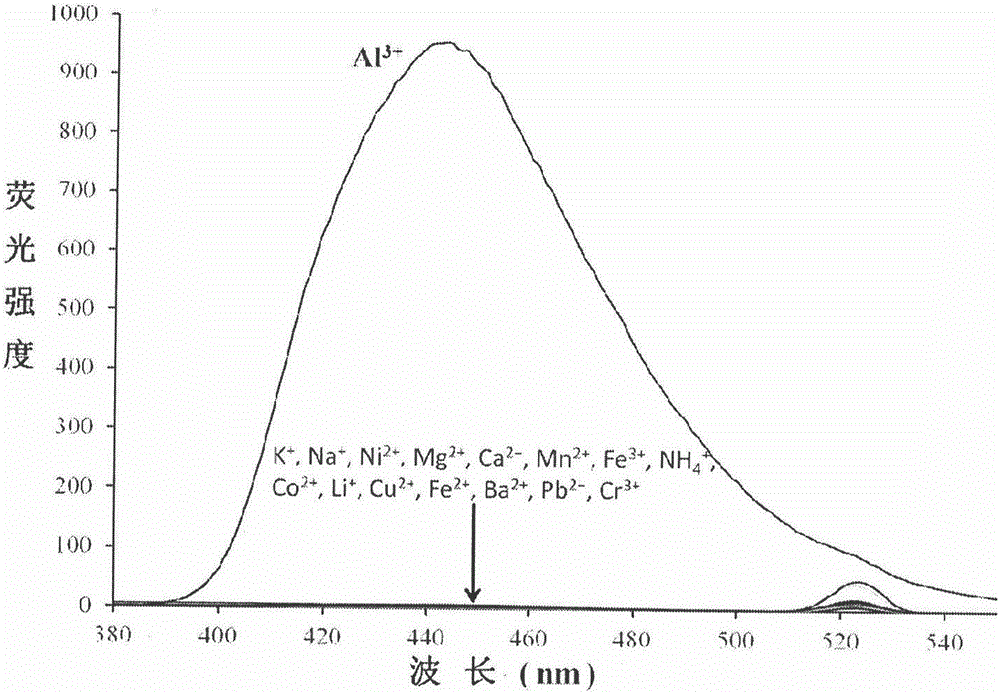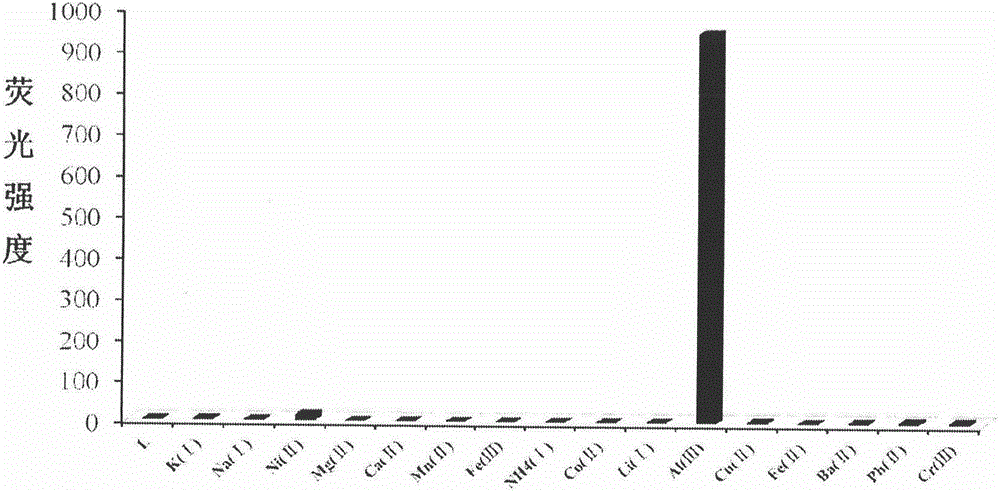Preparation method of fluorescent probe and application of fluorescent probe in aluminum ion detection
A fluorescent probe, aluminum ion technology, applied in the field of metal ion analysis and detection, can solve the problems of difficulty in rapid detection, complex analysis steps, high operating costs, and achieve good selectivity and sensitivity, high selective recognition, and high yield. Effect
- Summary
- Abstract
- Description
- Claims
- Application Information
AI Technical Summary
Problems solved by technology
Method used
Image
Examples
preparation example Construction
[0029] The invention provides a method for preparing a fluorescent probe, comprising the following steps:
[0030] 2-Hydroxy-1-naphthalene aldehyde and carbohydrazide are refluxed in a mixed solvent of ethanol and water to obtain trans 2-((2-hydroxynaphthalene-1-yl)methylene)hydrazine with formula I structure carbonylhydrazine,
[0031]
[0032] In the present invention, the reaction system of the reflux reaction is obtained by mixing 2-hydroxyl-1-naphthaldehyde ethanol solution and carbohydrazide aqueous solution. The present invention preferably mixes 2-hydroxyl-1-naphthaldehyde with absolute ethanol, and obtains 2-hydroxyl-1-naphthaldehyde ethanol solution after heating. The present invention has no special limitation on the operation of mixing and heating, and the technical solution of mixing and heating well known to those skilled in the art can be adopted. In the present invention, the heating is preferably water bath heating; the heating temperature is preferably 4...
Embodiment 1
[0055] Preparation of fluorescent probes:
[0056] (1) Using 10 mL of absolute ethanol as a solvent, dissolve 50 mg of 2-hydroxy-1-naphthaldehyde in a reaction flask, heat up to 45 °C at a rate of 4 °C / min, and hold for 30 min;
[0057] (2) Using 10mL of water as a solvent, dissolve 108mg of carbohydrazide, add it dropwise to the reaction flask at a rate of 3mL / min, and heat under reflux at 45°C for 4.5 hours;
[0058] (3) Cool the reacted mixed solution to room temperature at a rate of 1°C / min, filter it with suction, wash it with water three times, and dry it in an oven at 80°C for 45 minutes;
[0059] (4) Heating to 35° C. for recrystallization with methanol as a solvent to obtain a fluorescent probe with a yield of 81%.
[0060] The H NMR spectrum results are as follows:
[0061] 1 HNMR (600MHz, DMSO-d 6 )δ11.03(s, 1H), 9.19(s, 1H), 8.36(d, J=8.6Hz, 1H), 7.89(t, J=7.8Hz, 3H), 7.60(t, J=7.6Hz, 1H), 7.41(t, J=7.4Hz, 1H), 7.23(d, J=8.9Hz, 1H).
[0062] The carbon spectr...
Embodiment 2
[0077] The detection of aluminum ion in the aqueous solution of the fluorescent probe prepared in embodiment 1:
[0078] (1) The fluorescent probe is prepared into a mother solution with a concentration of 1 mmol / L using N,N-dimethylformamide as a solvent;
[0079] (2) the mother liquor and the concentration that step (1) obtains are 2 * 10 -5 mol / L aluminum ion solution mixed to detect the fluorescence intensity;
[0080] (3) According to the fluorescent intensity and linear equation described in step (2), it is determined that the aluminum ion concentration is 1.982 × 10 -5 mol / L, the error is 0.90%.
PUM
 Login to View More
Login to View More Abstract
Description
Claims
Application Information
 Login to View More
Login to View More - R&D
- Intellectual Property
- Life Sciences
- Materials
- Tech Scout
- Unparalleled Data Quality
- Higher Quality Content
- 60% Fewer Hallucinations
Browse by: Latest US Patents, China's latest patents, Technical Efficacy Thesaurus, Application Domain, Technology Topic, Popular Technical Reports.
© 2025 PatSnap. All rights reserved.Legal|Privacy policy|Modern Slavery Act Transparency Statement|Sitemap|About US| Contact US: help@patsnap.com



